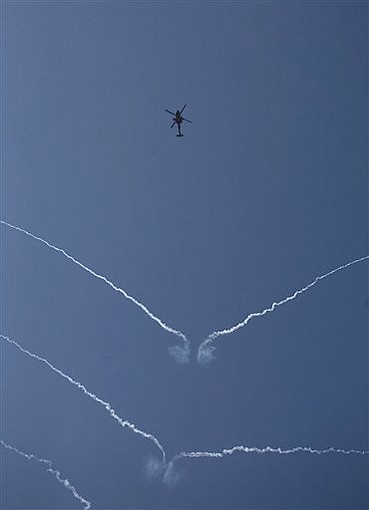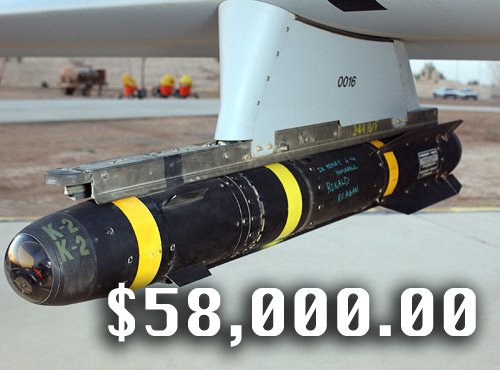DEB RIECHMANN, Associated Press
KABUL, Afghanistan — Once sharply curtailed because of complaints over civilian casualties, U.S. and NATO forces have ramped up the air war in Afghanistan since this summer.

n this photo taken on Nov. 11, 2010 in Sangin, Afghanistan, an attack helicopter shoots flares during a support mission for U.S. Marines. Once sharply curtailed because of complaints over civilian casualties, U.S. and NATO forces have ramped up the air war in Afghanistan since this summer. Coalition aircraft dropped 1,000 bombs and missiles in October _ one of the highest monthly totals of the 9-year-old war. (Photo: AP/Dusan Vranic)
Coalition aircraft dropped 1,000 bombs and missiles in October — one of the highest monthly totals of the 9-year-old war. Despite large increases in sorties and weapons fired, the number of civilians killed in air operations is slightly down this year — NATO officials say — because of coalition restrictions on engaging insurgents.
Top NATO commander Gen. David Petraeus' counterinsurgency strategy calls for securing population centers and bolstering governance and economic development, but at the same time he's unleashed heavy force on the battlefield. The international force is trying to kill and capture insurgent leaders to pressure the Taliban to give up the fight and reconcile with the Afghan government.
The air war in Afghanistan, which began on Oct. 7, 2001 when President George W. Bush ordered strikes on Taliban targets, has accelerated every month since July as 30,000 U.S. troops have streamed into the country and coalition forces have penetrated deeply into Taliban strongholds.
"We're seeing about a 20 percent increase in sorties over last year," Col. James Sturgeon, chief of the air operations control center in Kabul, said in an interview. "In the last couple weeks, it's dropping off a little bit as we get into the winter months" when military operations traditionally decline.
So far this year, coalition aircraft have used 4,615 bombs and Hellfire missiles, already exceeding the 4,184 dropped in all of last year.
The escalation of the war comes as Afghan President Hamid Karzai is publicly calling for a smaller military footprint. Karzai says he wants international troops to be less disruptive of daily Afghan life.
"I'm not a pro-gun person," Karzai said in a recent interview with The Washington Post. "I don't like guns or airplanes so I can never talk in favorable terms about planes that are shooting people or bombing people."
Karzai has repeatedly called on NATO to do more to protect civilians during stepped-up military operations. In response, former NATO commander Gen. Stanley McChrystal severely limited the circumstances in which troops could call in an airstrike or fire into buildings where civilians might be inside.
The revised rules, which are classified, never prevented U.S. troops from calling in air support, but some officers were exerting excessive caution, fearing career damage if civilians were mistakenly killed. Analysts said the rules were being interpreted and implemented unevenly across the country.
When Petraeus arrived in July, he reiterated the tactical directive, but emphasized that officers in the field should not add restrictions to his rules.
"We have seen a little bit of loosening of the reins, but in terms of making sure there are no civilians in an area where we want to strike offensively, it's a very disciplined process," Sturgeon said.
Fifty-nine civilians were killed during sorties flown by airplanes and helicopters between Jan. 1 and Nov. 18 this year. That's about 5 percent lower than the 62 killed during the same period last year, according to figures provided by the coalition.
"Civilian deaths are slightly down this year despite an enormous increase in the number of weapons dropped and sorties run," said Lt. Col. John Dorrian, a spokesman for the coalition. "The increase in air operations are often in support of troops on the ground who are pushing into historic insurgent safe havens — dangerous operations, very tough fighting that is intended to push them aside and protect the civilian population."

Every Hellfire missile fired in Afghanistan costs $58,000
This fall, coalition aircraft destroyed housing compounds that insurgents had turned into bomb factories in Arghandab, Zhari and Panjwai districts surrounding the southern city of Kandahar.
"Many times those compounds will be bobby trapped with IEDs," Sturgeon said. "If we can seize them we will, but if they are laced with IEDs, then usually we'll just go ahead and blow the whole compound rather than expose our troops to those kinds of dangers."
Since the beginning of the war, U.S.-led forces have made extensive use of airpower because of a shortage of troops, Afghanistan's mountainous terrain and the sheer size of the country.
However, airstrikes were widely blamed for the rise in civilian casualties as the tempo of the war accelerated in 2005 and 2006, prompting Karzai as well as international human rights groups to call on the coalition to cut back on the use of airpower.
A September 2009 airstrike on two fuel tankers seized by the Taliban killed up to 142 people, many of them civilians, and led to the resignation of the top commander of the German army and a deputy defense minister.
Nevertheless, use of airpower provides a major tactical advantage to coalition forces, especially in the rugged mountains of eastern Afghanistan where insurgents frequently attack isolated combat outposts which are difficult to resupply and defend.
The largest number of sorties in October were flown in the east, where the coalition is targeting militant leaders, including those with the Haqqani network, a Taliban faction affiliated with al-Qaida.
Mohammad Rahman Danish, a former district chief in eastern Afghanistan, said he's noticed a recent increase in air operations in parts of Kunar province. He said the bombings take place both day and night, targeting individual insurgents or militants on the move.
"Unfortunately there has been an increase in Pech Valley and other parts of Kunar as well," Danish said. "The people in the area are very angry at both sides. The Taliban are coming and influencing the residents and the Americans are conducting operations. The local people are suffering. Houses are destroyed. The land is destroyed in the operations. This is the reality." --AP



